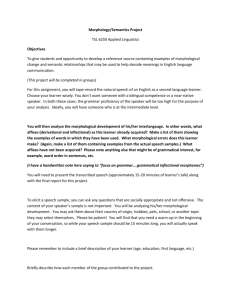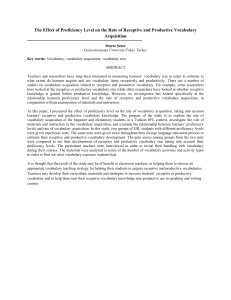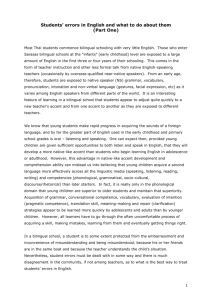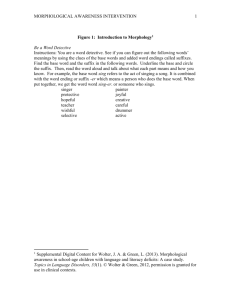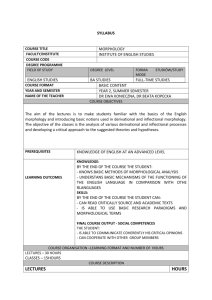Morphological awareness and second language receptive and
advertisement
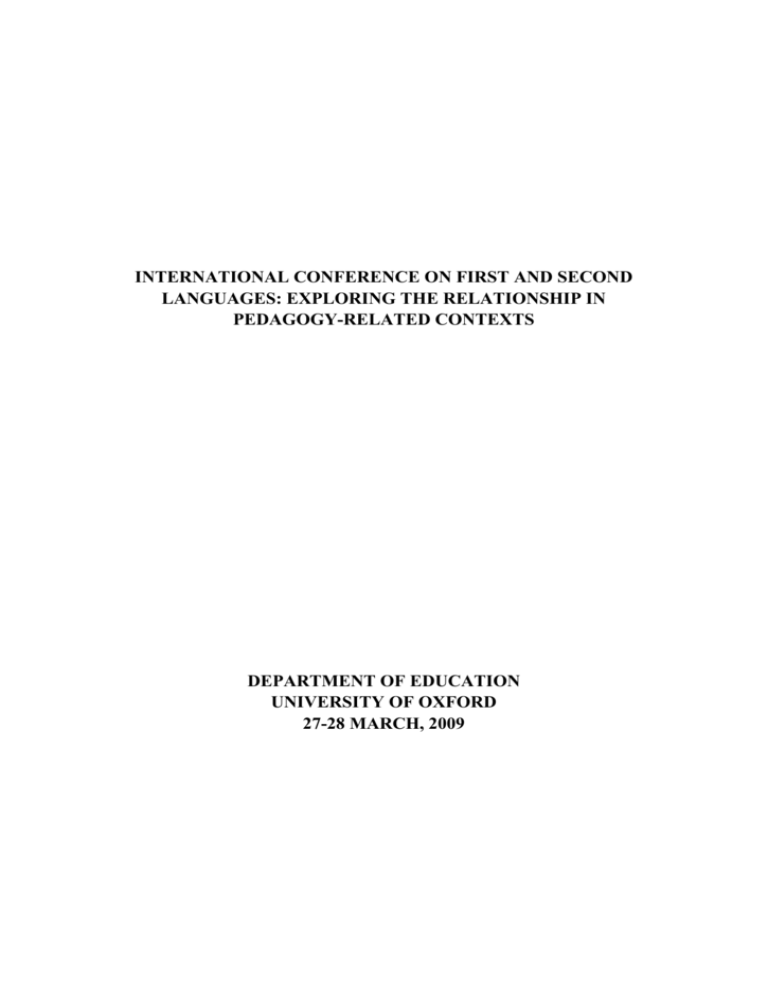
INTERNATIONAL CONFERENCE ON FIRST AND SECOND LANGUAGES: EXPLORING THE RELATIONSHIP IN PEDAGOGY-RELATED CONTEXTS DEPARTMENT OF EDUCATION UNIVERSITY OF OXFORD 27-28 MARCH, 2009 Morphological awareness and second language receptive and productive vocabulary knowledge in Japanese learners of English Yuko Hayashi University of Oxford Victoria A. Murphy University of Oxford ADDRESS FOR CORRESPONDENCE Yuko Hayashi Department of Education University of Oxford 15 Norham Gardens Oxford OX2 6PY E-mail: yuko.hayashi@education.ox.ac.uk Tel: 07949102102 ABSTRACT Despite the considerable body of vocabulary research, specific relationships between different types of vocabulary knowledge (VK) (i.e., receptive and productive) and morphological awareness (MA) are not well understood. This is particularly so for learners of a second language, and in particular Japanese ESL learners (JESLLs). Therefore, this study focussed on these aspects of VK and found that on tests of both VK and MA. As predicted, the JESLLs demonstrated more knowledge of receptive than productive vocabulary. In addition, productive MA was positively related to both receptive and productive VK for the JESLLs differing from the pattern observed for the native speakers (NSs) of English, whose receptive MA correlated with both types of VK. Further- more, the JESLLs were more adept at morphological segmentation than a comparison group of NSs, a finding which highlights the influence of instruction in developing MA. These findings are discussed in terms of considerations of both breadth and depth of VK in relation to MA, a key aspect of many other linguistic skills (e.g., reading). INTRODUCTION In trying to better understand the nature of vocabulary knowledge (VK), researchers are interested in both a) how many words learners know (i.e., breadth of vocabulary knowledge), often indicated by their knowledge of form and meaning of lexical items; and b) how well learners know particular words (i.e., depth), which entails various receptive and productive subcomponents of word knowledge. One essential subcomponent has been argued to be morphological awareness (MA), which includes knowledge of inflectional and derivational forms of base words (Nation, 1990, 2001). Despite the fact that MA plays an important role in the development of learners’ vocabulary knowledge, together with literacy-related skills (e.g., reading and spelling) (e.g., Wang, Cheng, & Chen, 2006), comparatively little research has really looked at the relationship between breadth and depth of VK in relation to MA. Specifically, we feel that more work needs to be carried out to identify more precisely the relationship between both receptive and productive VK and different aspects of MA, and in particular, the nature of this relationship in second language (L2) learners. The present study describes the nature of VK via Henriksen’s (1996, 1999) model of vocabulary acquisition (reproduced as Figure 1), which represents three separate but related continua: 1) partial-precise; 2) depth-of-knowledge; and 3) receptive-productive. 1 Henriksen’s model infers that the receptive-productive continuum concerns different levels of control over and access to VK that learners possess, as demonstrated by their performance on different kinds of tasks. The depth-of-knowledge continuum includes various subcomponents of word knowledge (e.g., pronunciation, associations, syntactic and morphological knowledge) and contributes to knowledge of word meaning, which develops along the partial-precise continuum. I. The partial-precise continuum; II. The receptive-productive continuum III. The depth-of-knowledge continuum Figure 1. A model of vocabulary acquisition (Henriksen, 1996) 2 RECEPTIVE AND PRODUCTIVE VOCABULARY SIZE As is often observed in first language (L1) learners, L2 learners, too, possess a larger receptive vocabulary size (VS) than productive VS, thus representing a gap (e.g., Laufer, 1998; Laufer & Paribakht, 1998). There is emerging evidence adding more detail to this prevailing notion. Waring (1997), for instance, suggested that there was a reason- able chance (64.5%) that upper-intermediate learners of English as a foreign language (EFL) knew high-frequency words both receptively and productively. Webb (2008), using receptive (L2 L1) and productive (L1 L2) translation tests, found that when their partial knowledge was considered, Japanese EFL learners possessed productive knowledge of almost all the words (93%) that they knew receptively. 1 This led Webb to suggest that explicit vocabulary teaching in the EFL context might contribute to the balanced development of receptive and productive VS. It appears that L2 learners’ re- ceptive and productive VK of some L2 (high-frequency) words overlap and interact with one another, moving along the continua of receptive-productive and precise-partial dimensions, as captured well in the Henriksen model above. This model is explored in more detail below with reference to MA as an aspect related to depth of VK and its relationship with VS. In this scoring system, learners’ incorrect spelling and grammatical forms were marked as correct as long as their meaning was correctly indicated. 1 3 MORPHOLOGICAL AWARENESS Morphological awareness (MA) refers to the ability to distinguish and manipulate the structure of morphemes, the smallest meaning-bearing units in language (e.g., un- and happy in unhappy), and includes knowledge of inflectional and derivational morphemes (McBride-Chang, Wagner, Muse, Chow, & Shu, 2005). Inflectional morphemes usu- ally serve a grammatical function such as marking tense (walk walked) or number (cat cats), and adding an inflectional suffix to a word stem does not alter the word’s overall syntactic category (Katamba, 1993). Derivational morphemes form words dif- ferently (Koda, 2000): either by a) altering the syntactic category (i.e., class-changing morphemes) (e.g., happy-happiness); or b) changing the meaning of the base without changing the syntactic category (i.e., class-maintaining morphemes) (e.g., happy-unhappy). The relationship between affixes and their base also has psycholinguistic aspects (Marslen-Wilson, Tyler, Waksler, & Older, 1994). Among these, the present study fo- cuses on frequency (i.e., the number of words in which an affix occurs), productivity (i.e., the degree to which an affix is used to form new words) and semantic transparency (happiness (transparent); release (opaque)) since the combination of these factors is argued to influence the way in which morphologically complex words are processed in 4 the mental lexicon (Lowie, 2000) (see Marslen-Wilson, 2007 and Murphy, 2004 for psycholinguistic accounts of this issue). THE RELATIONSHIP BETWEEN MORPHOLOGICAL AWARENESS AND VOCABULARY SIZE Schmitt and Meara (1997) demonstrated that receptive and productive MA were each positively related with receptive VS, although an increase in VS over time did not contribute to narrowing the gap between receptive and productive MA in Japanese EFL learners. This relationship could perhaps be explored in more detail by using a pro- ductive measure of VS as well. Schmitt and Meara also argue that Japanese learners possess stronger awareness of inflectional suffixes than derivational affixes, due to the idiosyncratic nature of the latter, as opposed to the rule-based nature of the former. More recently, Schmitt and Zimmerman (2002) suggest that L2 learners undergo significant challenges in acquiring productive knowledge of derivational affixes (considering the fact that even native speakers demonstrated imperfect productive knowledge of these), and that attending to form through instruction might help enhance this knowledge in L2 learners. This pedagogical implication, as well as a similar sugges- tion by Webb (2008) regarding VS (i.e., the potential role of explicit vocabulary teaching in the balanced development of receptive and productive VS), supports claims made 5 by SLA researchers about form-focused input in the L2 classroom (e.g., Doughty & Williams, 1998). Taking into account the type of L2 instruction that learners receive should, therefore, provide a basis for better understanding their developing VS and MA. The present study explores the nature of the relationship between receptive and productive VS and MA in the context of Japanese learners of English as an L2 (ESL). This is a comparatively under-researched issue, yet investigating it contributes to obtaining a clearer picture of the nature of VK in L2. In doing so, it also investigates to what extent these learners’ receptive and productive VS converge or diverge across words of differing frequencies. Their depth of VK is examined in relation to MA, with a consideration of morphological properties inherent in words such as frequency, productivity and semantic transparency, as well as inflections and derivations. METHODOLOGY The present study was designed to answer the following specific questions: (1) To what extent is receptive vocabulary size different from productive vocabulary size among Japanese ESL learners and native speakers of English respectively? a. If it is different, how do receptive and productive vocabulary size differ across frequency levels between the two groups? (2) Do these participants’ receptive and productive morphological awareness differ depending on the type of affixes included in the word? 6 a. Can it also be explained by the influence of frequency and productivity of affixes and semantic transparency? (3) Is the relationship between morphological awareness and vocabulary size found for these learners different from that for native speakers? Participants 42 participants were involved in this study: 22 Japanese ESL learners (JESLLs) of intermediate proficiency at a language school in Oxford, UK (3 males and 19 females; mean age = 28.8) and a comparison group of 20 adult native speakers (NSs) of English in Oxfordshire and Cheshire (10 males and 10 females; mean age = 29.5). Their teachers informed us that they explicitly taught the JESLLs formal aspects of morphology regularly in their vocabulary classes, using various morphological tasks. teachers used no morphological tasks in class during this study. These The JESLLs’ length of residence in Oxford and years of learning English were, on average, 8.2 months (SD = 14.3) and 11.1 years (SD = 5.1) respectively. Instruments A short background questionnaire and four tasks were used in this study. Two vocab- ulary tasks were used, namely Schmitt, Schmitt and Clapham’s (2001) Vocabulary Levels Test (VLT) as a receptive measure of VS and Laufer and Nation’s (1995) productive 7 version of the Vocabulary Levels Test (PVLT) as a productive measure. Both tests consist of five levels of word frequency in English: the 2,000-word level; the 3,000-word level; Academic Vocabulary (AV)/University Word Level (UWL) (for the PVLT); the 5,000-word level; and the 10,000-word level. The VLT involves matching a word with its correct definition from multiple choices. There are 150 test items in total (30 items at each frequency level). The PVLT, which has 90 test items in total, involves producing correct word completions elicited in short sentences: 'He was riding a bi (bicycle)'. Two additional tasks were a Word Segmentation (WS) task, as a receptive measure of MA, and an Affix Elicitation (AE) task, as a productive measure. The WS task involves segmenting a word into morphological components, e.g., ' wondering _____ (wonder +ing)'. The AE task, modelled on Nation’s (2001, p. 100) morphological task, involves filling in the blanks by producing appropriate affixed forms, using cues provided in brackets, e.g., 'I went to the doctor for a _________ <consult> (consultation)'. The sentences used were sampled from the British National Corpus and kept as unambiguous as possible to avoid any confusion caused by syntax or semantics when participants accessed their morphological knowledge. Prefixes and suffixes in both morphological tasks were selected, based on the fol- 8 lowing levels of English affixes (Bauer & Nation, 1993): Level 2 Inflectional suffixes Level 3 The most frequent and regular derivational affixes Level 4 Frequent orthographically regular affixes Level 5 Regular but infrequent affixes Level 6 Frequent but irregular affixes Level 7 Classical roots and affixes Derivational affixes chosen from this list were further classified into class-maintaining and class-changing derivational affixes, a distinction that is lacking in this list. The frequency of the target affixed items was checked with data by Francis and Kučera (1982). The 34 target items appearing on the AE task were designed to elicit 10 inflectional suffixes, 12 class-maintaining and 12 class-changing derivational affixes. Included in the 34 target items on the WS task were a total of 50 target affixes to be identified through segmentation: 10 inflectional suffixes, 17 class-maintaining and 23 class-changing derivational affixes. The total sum of target affixes differs from that of the target items since the former reflects a number of affixes included in each target item, which varies across items, depending on their internal morphological complexities, such as unkind (one prefix) and irregularly (two affixes). The target deriva- tional forms in both tasks consisted of 6 nouns, 6 verbs, 6 adjectives, and 6 adverbs. A classification of the target affixes into Bauer and Nation’s levels is given in Table 1. 9 Table 1. The number of affixes included according to Bauer and Nation’s (1993) levels Tasks WS AE Level 2 10 10 Level 3 9 5 Level 4 Level 5 8 4 9 9 Level 6 Level 7 8 2 6 4 Procedure All tasks were administered by the researcher. A short background questionnaire and the four tasks were group-administered to the JESLLs at their language school. All the tasks were completed within two weeks, with two sessions (the PVLT and VLT) held on the same day and the other two sessions (the AE and WS tasks) held a week later. The NSs completed the four tasks in two sessions (the PVLT and VLT in one session and the AE and WS tasks in the other) in two groups (one group in Oxfordshire and the other in Cheshire). At the beginning of each session, participants received a brief explanation of the tasks, followed by a few examples from the researcher in Japanese for the JESLLs and in English for the NSs. There was no time limit on any of the tasks. These morphological tasks were pilot-tested prior to the data collection with 8 JESLLs and 6 NSs, none of whom were involved in the actual study. As a result, modification was made, especially by way of making clearer the semantics and syntax of some of the sentences appearing on the AE task. 10 RESULTS The participants’ responses to the PVLT and VLT were scored as either correct or incorrect. In the PVLT, as in Laufer (1998), responses expressed in the incorrect gram- matical form (e.g., debt for debts) or spelling (e.g., suppliment for supplement) were marked as correct if their meaning was correctly indicated. As in Webb (2008), we employed two scoring systems for the WS task: crude and sensitive. In the crude scoring system, the participants’ responses were marked as either correct or incorrect, compared against responses from two NS judges with expertise in Applied Linguistics. In the sensitive scoring system, one point was awarded to each affix correctly identified through segmentation. For example, the segmentation 'irregular + ly' was awarded one point due to the correct identification of the derivational suffix -ly (hence two points for 'ir + regular + ly'). Only the strict scoring system applied to the AE task, due to the availability of cues as a prompt to elicit target items. Vocabulary tasks The means and standard deviations for the VLT and PVLT scores are presented in Table 2. The total scores on both tasks were converted into percentages to allow for comparisons across both tests to be made. The VLT data were analysed using an analysis 11 Table 2. Means and standard deviations for scores on the VLT and PVLT JESLLs (n=22) Frequency levels VLT Mean SD NSs (n=20) PVLT Mean SD VLT Mean SD PVLT Mean SD 2,000 3,000 AV/UWL 5,000 26.1 22 20.6 16.8 3.67 5.1 6.34 5.76 13 8.27 7.45 3 2.65 4.31 3.69 2.7 29.8 29.8 29.2 29.6 0.55 0.91 1.55 0.99 18 17.8 17.5 17.6 0 0.55 0.76 0.83 10,000 Total (%) 8 62.4 3.95 14.67 0.2 35.4 0.5 13.48 29.6 98.6 1 2.1 16.3 96.7 2.24 4.2 Note. A maximum score at each frequency level was 30 for the VLT and 18 for the PVLT. of variance (ANOVA) with one repeated-measures variable (Word Category: 2,000-word, 3,000-word, Academic Vocabulary (AV), 5,000-word, and 10,000-word levels), and one between-subjects variable (Group: JESLLs and NSs). There was a main effect of word category, F(4, 160) =110.54, p < .001, and group, F(1, 40) = 119.25, p < .001. Furthermore, a significant Group × Word Category inter- action was found, F(4, 160) = 107.13, p < .001. The NSs’ performance was at a ceil- ing across frequency levels, as manifested by almost perfect (mean) scores achieved across the frequency levels (see Table 2). As for the JESLLs’ performance, while their mean scores on the 3,000-word level and AV did not differ significantly, p >.05., the second smallest difference in the means, which lay between the AV and 5,000-word level, reached statistical significance, t(21) = 4.91, p < .001. One can, therefore, extrapolate that the JESLLs’ performance significantly dropped with decreasing frequency (ex12 cept between the 3,000-word level and AV). A similar ANOVA was conducted with the PVLT data. A main effect of word category, F(4, 160) = 118.70, p < .001, and group, F(1, 40) = 379.65, p < .001 was observed. Moreover, there was a significant Group × Word Category interaction, F(4, 160) = 74.95, p < .001. When looking only at the JESLL data, as observed in the VLT, their VS dropped as the frequency level decreased, except between the 3,000-word level and UWL, where their mean scores did not differ significantly, p > .05. The NSs’ per- formance, in contrast, reached ceiling at all frequency levels but the 10,000-word level, as manifested by almost perfect (mean) scores achieved at all these four frequency levels (see Table 2). The difference between the JESLLs’ total scores on the VLT and PVLT reached statistical significance, t(21) = 22.0, p < .001, suggesting that their receptive VS was significantly larger than their productive VS. The NSs’ receptive VS, too, was significantly larger than their productive VS, t(19) = 2.41, p < .05. Pearson correlations were calculated and receptive VS strongly correlated with productive VS for the JESLLs, r = .92, p < .001. A weaker, but still significant corre- lation was found for the NSs, r = .56, p < .001. Therefore, for both groups of partici- pants, as scores on the receptive measure increased, scores on the productive measure also increased, illustrating a positive relationship between receptive and productive VS. 13 Morphological tasks The data from the WS task (sensitive scores, a sum of scores awarded to each affix type) were analysed using an ANOVA with one repeated-measures variable (Affix Type: inflectional suffixes, class-maintaining and class-changing affixes) and one between-subjects variable (Group: JESLLs and NSs). A main effect of affix type, F(2, 80) = 22.43, p < .001, and group, F(1, 40) = 14.29, p < .01 was observed. There was a significant Group × Affix Type interaction, F(2, 80) = 7.92, p < .01. These effects are shown in Figure 2. The JESLLs scored most highly on inflectional suffixes and performed significantly better on class-maintaining affixes than class-changing affixes, t(21) = 5.2, p < .001. Their mean scores on inflec- tional suffixes and class-maintaining affixes did not differ significantly, p > .05. Figure 2. Mean percentage of correct responses to the WS task 14 The NSs, in contrast, performed highly only on class-maintaining affixes. No significant difference was found between the means for inflectional suffixes and class-changing affixes p > .05. When comparing scores between the groups, independent-samples t-tests indicated that the JESLLs performed significantly better on the class-changing affixes than did the NSs, t(40) = 3.01, p < .01, whereas no significant between-subject difference was found for the class-maintaining affixes, p >.05. One can extrapolate from this difference that the larger between-subject difference in the means for the inflectional suffixes was significant, too. The Cronbach Alpha reliability coefficient for this task was .89. A similar ANOVA was conducted with data from the AE task. There was a main effect of affix type, F(2, 80) = 33.32, p < .001, and group, F(1, 40) = 166.11, p < .001. Furthermore, a significant Group × Affix Type interaction was found, F(2, 80) = 29.94, p < .001. These effects are illustrated in Figure 3. The NSs scored highly on inflec- tional suffixes and class-changing affixes (no significant differences in the means between these types of affixes, p > .05), contrasting with their performance on the WS task. The NSs performed significantly better on class-changing affixes than class-maintaining affixes, t(19) = 2.91, p < .01, whereas their mean scores did not differ significantly between inflectional suffixes and class-maintaining affixes, p > .05. 15 The JESLLs performed well Figure 3. Mean percentage of correct responses to the AE task only on inflectional suffixes. Their mean scores on inflectional suffixes were signifi- cantly higher than those on class-maintaining affixes, t(21) = 7.75, p < .01. The dif- ference in the means between class-maintaining and class-changing affixes did not reach statistical significance, p > .05. The smallest between-subject difference lay in the means for the inflectional suffixes and this difference reached statistical significance, t(40) = -5.62, p < .001. Hence, one can extrapolate that the NSs significantly outperformed the JESLL on the other affix types as well. The Cronbach Alpha reliability coefficient for this task was high at .96. Influence of frequency, productivity and semantic transparency Participants’ responses to the WS and AE tasks were analysed more qualitatively to explore the influence of frequency, productivity and semantic transparency on them (see 16 table 1 for a classification of test items into Bauer and Nation’s (1993) levels of affixes). On the WS task, both groups received full marks in the two scoring systems on the following items: disorder (level 7), enable (level 5), rewrite (level 6) and childhood (level 5). Although these items differ in terms of frequency and productivity (both decrease as the level increases), they can all be considered semantically transparent in terms of the relationship between the affixes and their base. In comparison to this fa- cilitative influence of semantic transparency, the influence of frequency and productivity on participants’ performance was less consistent. Despite having received instruc- tions on the task together with examples at the beginning of the testing session, the NSs seem to have still been influenced more by phonological properties of test items, as indicated by their syllabic segmentation (e.g., 'won + der + ing', 'con + ven + tion', and 'dis + sim + i + lar'), whereas the JESLLs typically segmented items into morphological components across levels (e.g., 'wonder + ing' (level 2), 'conven + tion' (level 7), and 'dis+ similar' (level 5)). Individual responses to the AE task, too, render the influence of frequency and productivity unclear since they lacked a uniformly decreasing relationship across levels. The JESLLs provided the derivational form unfortunately (un level 3) more correctly than irrelevant (ir- level 5). On the other hand, a different tendency in responses was 17 observed within the same frequency and productivity level (e.g., -hood and -ent at level 5): the former exhibited only naturally-occurring forms as answers (neighbourhood or neighborhood), whereas the latter triggered various non-existing forms (e.g., absorbly and absorbate). The NSs performed highly regardless of level, which offers little insight into the influence of frequency and productivity. Semantic transparency was not examined here since the bases of target morphological items were provided as cues in the AE task. It should be noted that the above analyses of both tasks are based on a small number of affixes at each level, thus only providing a limited picture of participants’ MA in terms of frequency, productivity and semantic transparency. Vocabulary size and morphological awareness Productive MA correlated highly with both receptive (r =.84, p < .001) and productive VS (r =.83, p < .001) among the JESLLs. In contrast, it was receptive MA (only sen- sitive scores) that moderately correlated with the NSs’ receptive (r =.46, p < .05) and productive VS (r =.58, p < .01). Regression analyses were conducted to examine the extent to which MA could be accounted for by receptive and productive VS. As for the JESLLs, these two types of VS explained 73% (F(2, 19) = 25.8, p < .001) of the variance in their productive MA. Among the NSs, the two types of VS explained 36% 18 (F(2, 17) = 4.79, p < .05) of the variance in their receptive MA. DISCUSSION Although the results indicated, as predicted, that the JESLLs’ receptive VS was significantly larger than their productive VS, the gap narrowed at the 2,000-word level, where the ratio of both types of VS was reasonably high (72%). The percentage lowered with decreasing frequency, which is in line with Waring (1997) and Webb (2008). The pos- itive correlation between the JESLLs’ receptive and productive VS, together with the relatively high ratio between receptive and productive size for high-frequency words, support the notion that receptive and productive vocabulary knowledge (VK) overlap and interact considerably with one another. This can best be viewed as the movement of receptive and productive vocabularies along a continuum. Consistent with Schmitt and Meara (1997), the JESLLs demonstrated stronger awareness of inflectional morphology than derivational morphology on both morphological tasks, perhaps due to its rule-based nature, in comparison to the idiosyncratic nature of derivational morphology. Such a tendency was not observed among the NSs. Semantic transparency appears to have been somewhat indicative of participants’ performance on the WS task, suggesting that morphological components are likely to be 19 recognised if the relationship between affixes and their base is semantically transparent. Neither frequency nor productivity accounted for the participants’ performance on the WS or AE task. The JESLLs’ lower performance on the AE task could be explained by a heavy cognitive demand placed on the JESLLs when accessing their productive morphological knowledge (see Figure 1). Thus, the participants’ performance on both tasks was perhaps largely an artefact of the nature of the tasks as well as, for the JESLLs, of affix types. An additional factor underlying the participants’ performance could be their degree of metalinguistic awareness. The JESLLs’ strong awareness of morphological segments, as manifested on the WS task, could be related to their regular exposure to explicit instruction about inflectional and derivational morphemes in their L2 vocabulary classes. This notion is clearly consistent with claims about form-focused instruction in L2 classrooms. However, the fact that the JESLLs, despite having re- ceived explicit instruction on formal aspects of morphology, did not do as well on the AE task, suggests that instruction must be targeted to specific skills and knowledge (receptive/productive). This area would indeed profit from well-considered research on the role that instruction can play on developing receptive and productive morphological knowledge. The relationship between MA and VS contrasted across the two groups: productive 20 MA was positively associated with the JESLLs’ receptive and productive VS, whereas receptive MA (sensitive scores) was positively related to the NSs’ receptive and productive VS. The lack of relationship for the NSs with their crude scores suggests that ac- tivating (explicit) knowledge of morphological segments probably does not coincide with the way in which the NSs use/recognise their L1 lexical items. The relationship for the JESLLs can be visualised via Henriksen’s model (Figure 1): productive MA as part of depth of vocabulary knowledge, which perhaps requires the level of complete productive control in a number of contexts, can contribute to the development of receptive and productive knowledge of form and meaning of L2 lexical items (i.e., breadth). The present study thus demonstrated the interrelatedness of breadth (VS) and depth of VK in relation to MA, which are both subcomponents essential for the development of vocabulary (and general linguistic) knowledge. CONCLUSION The present study illuminated a contrasting relationship between receptive and productive vocabulary size and morphological awareness between the JESLLs and NSs. One could argue that the JESLLs’ developing L2 mental lexicon is not simply a less developed version of the L1 mental lexicon but there might be some qualitative differences in the organisation of L1 and L2 mental lexicons. 21 Our findings are consistent with the notion that the L2 mental lexicon is characterised by higher degrees of metalinguistic awareness that includes explicit knowledge of morphological segments. Some limita- tions should be noted in this study, particularly regarding its small sample size, the use of American English frequency data (Francis & Kučera, 1982) for the JESLLs in the UK, and the limited vocabulary profile envisaged via the VLT and PVLT. Further work that remedies these limitations should be developed for a more comprehensive understanding of the nature of morphological awareness and its relationship with different aspects of vocabulary knowledge. 22 REFERENCES Bauer, L., & Nation, P. (1993). Word families. International Journal of Lexicography, 6(4), 253-279. Doughty, C., & Williams, J. (1998). (Eds.), Focus on form in classroom second language acquisition. Cambridge: Cambridge University Press. Francis, W. N., & Kucera, H. (1982). Frequency analysis of english usage: Lexicon and grammar. Boston: Houghton Mifflin Company. Henriksen, B. (1996). Semantisation, retention, and accessibility: Key concepts in vocabulary learning. Paper presented at the AILA Congress, Jyvaskyla, Finland. Henriksen, B. (1999). Three dimensions of vocabulary development. Studies in Second Language Acquisition, 21(2), 303-317. Katamba, F. (1993). Morphology. Basingstoke: Macmillan. Koda, K. (2000). Cross-linguistic variations in L2 morphological awareness. Applied Psycholinguistics, 21(3), 297-320. Laufer, B. (1998) The development of passive and active vocabulary in a second language: Same or different? Applied Linguistics, 19(2), 255-271. Laufer, B., & Nation, P. (1995). Vocabulary size and use: Lexical richness in L2 written production. Applied Linguistics, 16(3), 307-322. Laufer, B., & Paribakht, T. S. (1998). The relationship between passive and active vocabularies: Effects of language learning context. Language Learning, 48(3), 365-391. Lowie, W. (2000). Cross-linguistic influence on morphology in the bilingual mental lexicon. Studia Linguistica, 54(2), 175-185. Marslen-Wilson, W., Tyler, L. K., Waksler, R., & Older, L. (1994). Morphology and meaning in the English mental lexicon. Psychological Review, 101(1), 3-33. Marslen-Wilson, W. (2007). Morphological processes in language comprehension. In G. Gaskell (Ed.), Oxford handbook of psycholinguistics (pp. 175-193). Oxford: Oxford University Press. McBride-Chang, C., Wagner, R. K., Muse, A., Chow, B. W. Y., & Shu, H. (2005). The role of morphological awareness in children's vocabulary acquisition in English. Applied Psycholinguistics, 26(3), 415-435. Murphy, V. A. (2004). Dissociable systems in second language inflectional morphology. Studies in Second Language Acquisition, 26(3), 433-459. Nation, I. S. P. (1990). Teaching and learning vocabulary. Massachusetts: Newbury House. Nation, I. S. P. (2001). Learning vocabulary in another language. Cambridge: Cambridge University Press. Schmitt, N., & Meara, P. (1997). Researching vocabulary through a word knowledge framework. Studies in Second Language Acquisition, 19(1), 17-36. Schmitt, N., Schmitt, D., & Clapham, C. (2001). Developing and exploring the behaviour of two new versions of the vocabulary levels test. Language Testing, 18(1), 55-88. Schmitt, N., & Zimmerman, C. B. (2002). Derivative word forms: What do learners know? TESOL Quarterly, 36(2), 145-171. Wang, M., Cheng, C., & Chen, S. (2006). Contribution of morphological awareness to Chinese-English biliteracy acquisition. Journal of Educational Psychology, 98(3), 542. 24 Waring, R. (1997). A comparison of the receptive and productive vocabulary sizes of some second language learners. Retrieved August 4, 2008, from http://www1.harenet.ne.jp/~waring/papers/vocsize.html Webb, S. (2008). Receptive and productive vocabulary sizes of L2 learners. Studies in Second Language Acquisition, 30(1), 79-95. 25
